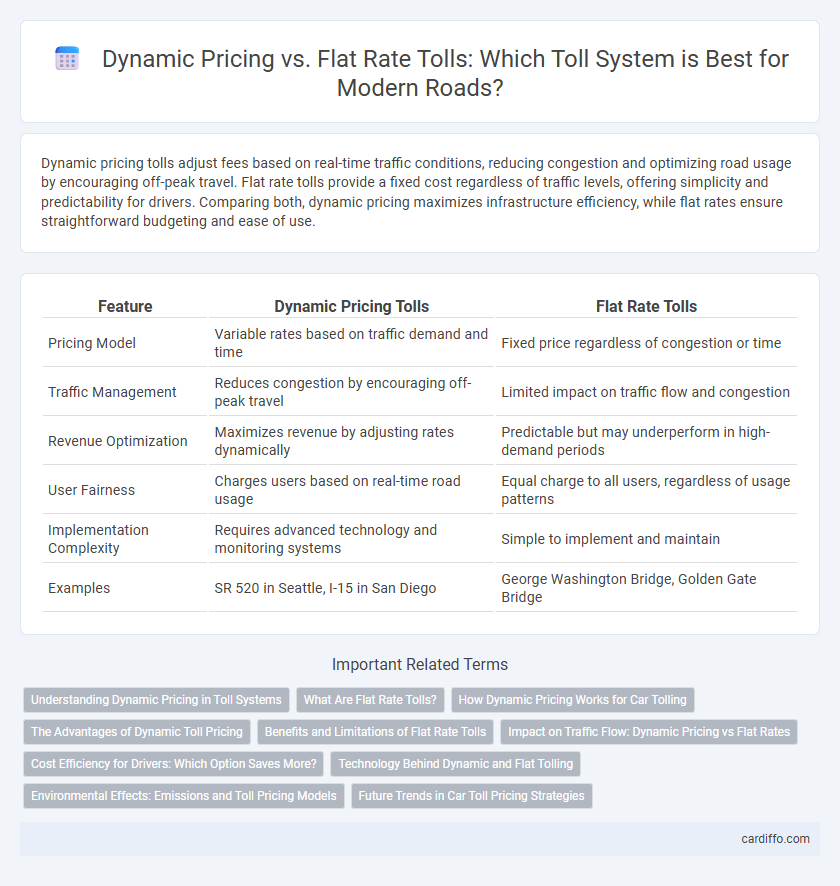Dynamic pricing tolls adjust fees based on real-time traffic conditions, reducing congestion and optimizing road usage by encouraging off-peak travel. Flat rate tolls provide a fixed cost regardless of traffic levels, offering simplicity and predictability for drivers. Comparing both, dynamic pricing maximizes infrastructure efficiency, while flat rates ensure straightforward budgeting and ease of use.
Table of Comparison
| Feature | Dynamic Pricing Tolls | Flat Rate Tolls |
|---|---|---|
| Pricing Model | Variable rates based on traffic demand and time | Fixed price regardless of congestion or time |
| Traffic Management | Reduces congestion by encouraging off-peak travel | Limited impact on traffic flow and congestion |
| Revenue Optimization | Maximizes revenue by adjusting rates dynamically | Predictable but may underperform in high-demand periods |
| User Fairness | Charges users based on real-time road usage | Equal charge to all users, regardless of usage patterns |
| Implementation Complexity | Requires advanced technology and monitoring systems | Simple to implement and maintain |
| Examples | SR 520 in Seattle, I-15 in San Diego | George Washington Bridge, Golden Gate Bridge |
Understanding Dynamic Pricing in Toll Systems
Dynamic pricing in toll systems adjusts road usage fees in real-time based on traffic demand, aiming to reduce congestion and optimize traffic flow. This method contrasts with flat rate tolls, which charge a fixed fee regardless of traffic conditions or time of day. By leveraging sensor data and traffic patterns, dynamic pricing encourages off-peak travel and enhances overall road efficiency.
What Are Flat Rate Tolls?
Flat rate tolls require drivers to pay a fixed fee regardless of the time of day, traffic conditions, or vehicle type, offering simplicity and predictability in travel costs. This pricing model is commonly used on many highways, bridges, and tunnels, providing straightforward revenue collection for transportation agencies. While flat rate tolls encourage consistent usage, they may not effectively manage congestion or optimize roadway capacity.
How Dynamic Pricing Works for Car Tolling
Dynamic pricing for car tolling adjusts toll rates based on real-time traffic conditions, demand, and congestion levels to optimize roadway efficiency and reduce traffic jams. Sensors and traffic data analytics continuously monitor vehicle flow, allowing tolls to increase during peak hours and decrease during off-peak times, encouraging drivers to alter travel times or routes. This adaptive pricing model helps manage road usage dynamically, improving traffic distribution and minimizing overall delays.
The Advantages of Dynamic Toll Pricing
Dynamic toll pricing adjusts fees based on real-time traffic conditions, reducing congestion and optimizing roadway capacity. This pricing model encourages off-peak travel, decreasing travel times and environmental impact by lowering emissions. Dynamic tolls generate more efficient revenue streams that can be reinvested into infrastructure maintenance and improvements.
Benefits and Limitations of Flat Rate Tolls
Flat rate tolls offer predictable costs for drivers, simplifying budgeting and reducing toll plaza congestion through uniform charges regardless of time or traffic conditions. However, they may lead to underutilization during off-peak hours and congestion during peak periods, as the static pricing does not incentivize load distribution. This limitation restricts the efficiency of traffic management compared to dynamic pricing models that adjust tolls to demand fluctuations.
Impact on Traffic Flow: Dynamic Pricing vs Flat Rates
Dynamic pricing tolls adjust fees based on real-time traffic conditions, effectively reducing congestion by incentivizing off-peak travel and optimizing road usage. Flat rate tolls, however, maintain a constant fee regardless of traffic volume, often leading to peak-hour bottlenecks and inefficient traffic distribution. Implementing dynamic pricing promotes smoother traffic flow and enhanced roadway capacity compared to static flat rate systems.
Cost Efficiency for Drivers: Which Option Saves More?
Dynamic pricing tolls adjust rates based on traffic congestion and time of day, enabling drivers to save money during off-peak hours by paying lower fees, thus enhancing cost efficiency. Flat rate tolls offer predictable, fixed payments regardless of traffic, which can be less economical during heavy congestion or peak times. For drivers focused on minimizing expenses, dynamic pricing often provides greater cost savings by incentivizing travel during less busy periods.
Technology Behind Dynamic and Flat Tolling
Dynamic pricing toll systems utilize real-time data analytics and IoT sensors to adjust rates based on traffic flow, congestion levels, and demand patterns, optimizing road usage and reducing bottlenecks. Flat rate tolling relies on static infrastructure such as RFID transponders and fixed cameras for vehicle identification, with predetermined charges regardless of traffic conditions. The integration of advanced GPS tracking and machine learning algorithms distinguishes dynamic systems by enabling adaptive pricing strategies that enhance efficiency compared to traditional flat tolling methods.
Environmental Effects: Emissions and Toll Pricing Models
Dynamic pricing tolls reduce traffic congestion by adjusting fees based on real-time demand, which leads to lower vehicle emissions compared to flat rate tolls. Flat rate tolls often cause uneven traffic flow and increased idling, resulting in higher pollution levels. Studies show that dynamic tolling can significantly decrease carbon emissions in urban areas by promoting off-peak travel and smoother traffic patterns.
Future Trends in Car Toll Pricing Strategies
Future trends in car toll pricing strategies emphasize the shift from flat rate tolls to dynamic pricing models that adjust costs based on real-time traffic conditions and demand patterns. Advanced technologies like AI, IoT sensors, and big data analytics enable more precise congestion management and revenue optimization by varying toll rates throughout the day. This approach aims to reduce traffic congestion, lower emissions, and improve overall road network efficiency while offering drivers cost-based incentives aligned with peak and off-peak travel times.
Dynamic pricing vs flat rate tolls Infographic

 cardiffo.com
cardiffo.com